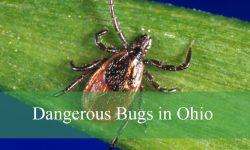The wetlands and forests of Illinois are alive with frogs of many kinds, including the tiny Spring Peeper and the large American Bullfrog. Each species has its own unique call, behavior, and habitat, making them a fascinating part of the state’s wildlife.
Frogs play an important role in Illinois ecosystems, helping to control insect populations while also serving as food for birds, snakes, and other animals. Their seasonal calls are a welcome sign of spring and summer across wetlands and forests.
In this guide, you’ll learn about 14 types of frogs found in Illinois. With pictures and identification tips, it will help you recognize their characteristics, calls, and the best places to observe them in the wild.
Different Types of Frogs Found in Illinois
American Bullfrog (Lithobates catesbeianus)
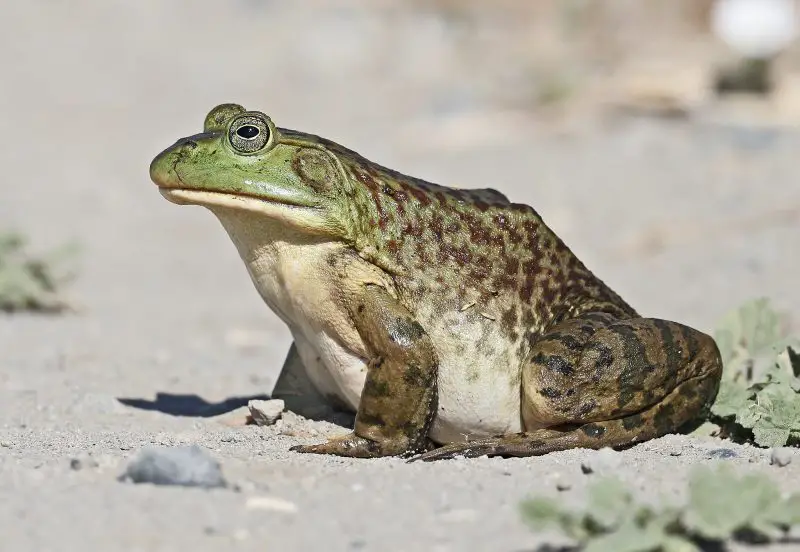
The American Bullfrog is the largest frog species in Illinois, easily recognized by its impressive size and deep, booming call that can carry across ponds and lakes. Adults often measure 3.5 to 8 inches in length, with powerful hind legs adapted for long jumps and swimming. Their coloration ranges from green to brown with darker blotches, helping them blend into wetland vegetation.
This species is most commonly found around permanent bodies of water, such as lakes, large ponds, slow-moving rivers, and marshes. They prefer habitats with abundant aquatic vegetation that provides cover from predators. Bullfrogs are strong swimmers and rarely stray far from water.
Diet plays a big role in their survival, as bullfrogs are opportunistic feeders. They eat insects, small fish, other frogs, crayfish, and even small birds and mammals when available. Their aggressive feeding habits contribute to their dominance in aquatic ecosystems.
In Illinois, bullfrogs are widespread and can be heard calling during warm summer nights. Their breeding season begins in late May and continues through July, with females laying large clusters of eggs that float on the water’s surface.
Green Frog (Lithobates clamitans)
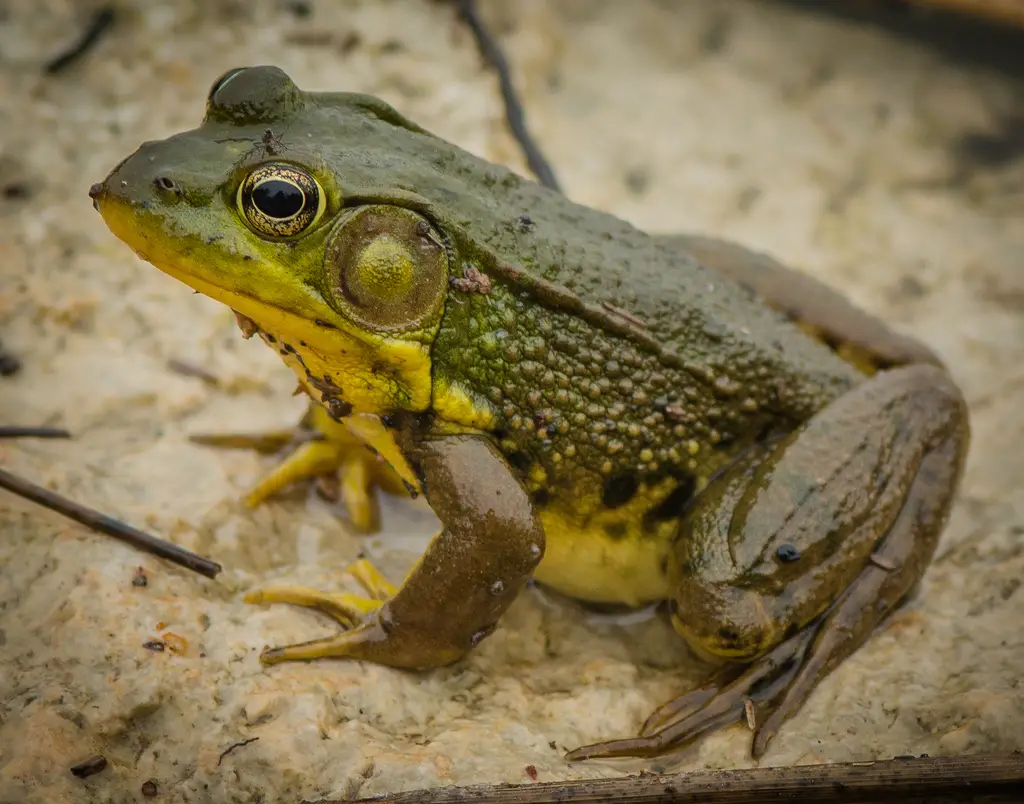
The Green Frog is slightly smaller than the bullfrog, usually measuring 2.5 to 4 inches in length. It is identified by its green to brown coloration, ridges running along each side of its back, and its loud “banjo-like” call. The eardrum (tympanum) is often larger in males than females, making it an easy way to distinguish between the sexes.
These frogs inhabit a wide variety of freshwater environments, including ponds, marshes, streams, and lakes. Unlike bullfrogs, green frogs are often found near the edges of water bodies, sitting on rocks or vegetation, ready to leap in at any sign of disturbance.
Their diet consists primarily of insects, spiders, small crustaceans, and sometimes small frogs or fish. They are ambush predators, waiting patiently for prey to pass before striking with their sticky tongues.
In Illinois, green frogs are common and active from late spring through early fall. Their breeding season begins in May, and males call from shallow waters to attract females. Egg masses are smaller than those of bullfrogs but still contain thousands of eggs.
Pickerel Frog (Lithobates palustris)
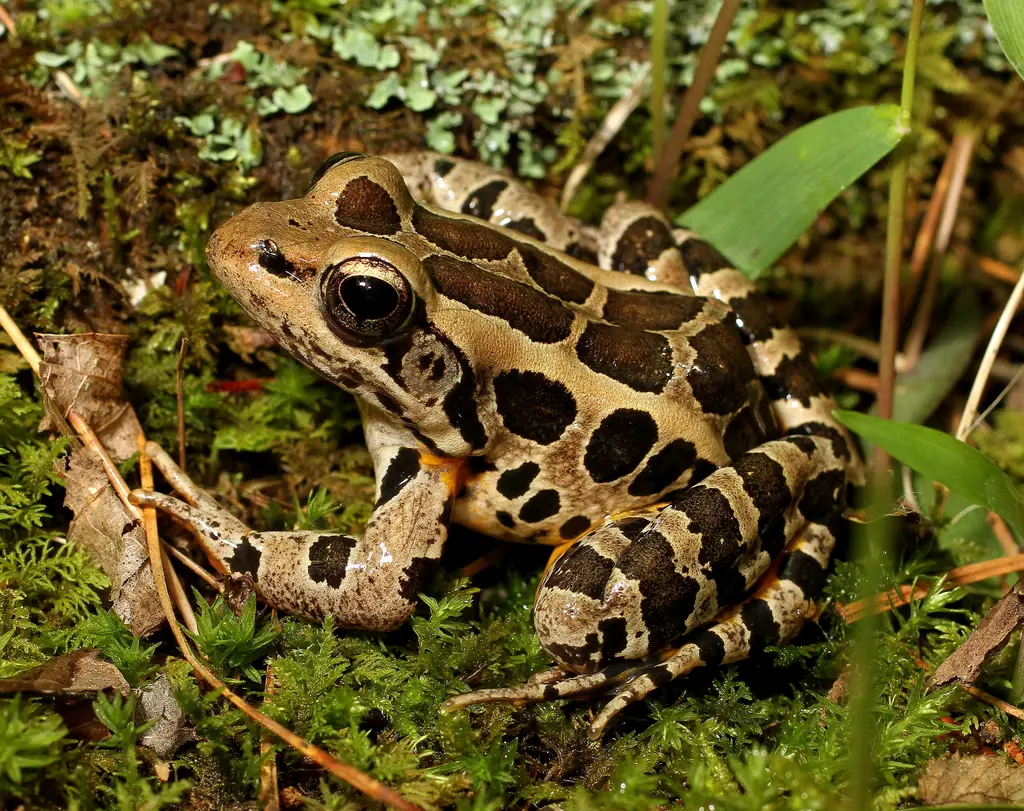
The Pickerel Frog is easily identified by its two rows of dark square-shaped spots running down its back, along with bright yellow or orange coloration on the inner thighs. Adults are medium-sized, measuring 1.75 to 3 inches in length. Their appearance makes them one of the most striking frog species in Illinois.
This species prefers cool, clear streams, ponds, and wetlands, often in areas with abundant vegetation. They are more tolerant of colder water than many other frogs, making them unique in their choice of habitat.
One notable feature of pickerel frogs is their mild toxicity. Their skin secretes a substance that can be irritating to predators and even to humans if handled excessively. This makes them less likely to be eaten by many animals compared to other frog species.
In Illinois, pickerel frogs breed in early spring, often in late March and April. Their call is a low, snore-like sound that helps distinguish them from leopard frogs. They are less common than bullfrogs or green frogs but can be spotted in the right habitats.
Northern Leopard Frog (Lithobates pipiens)
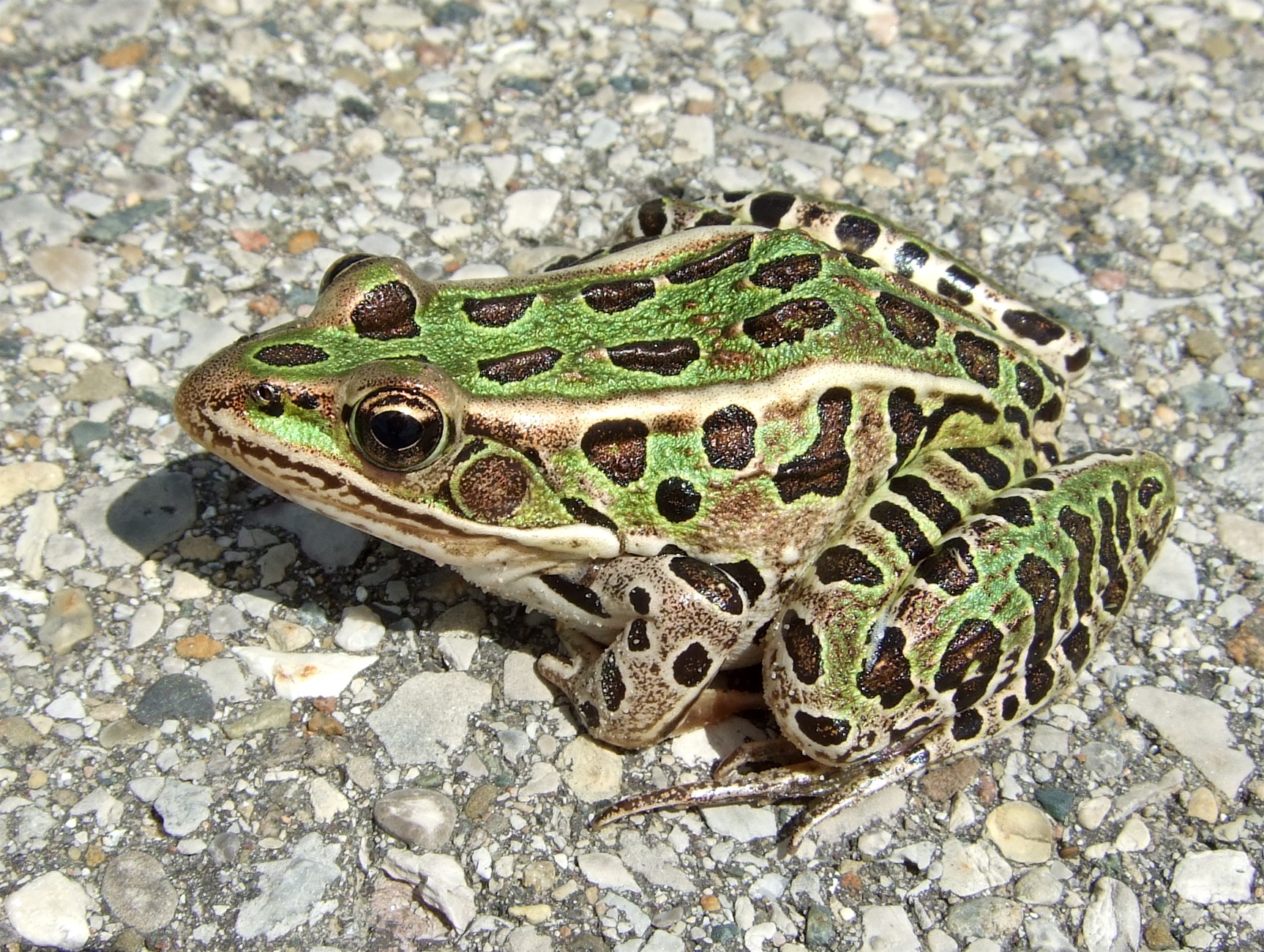
The Northern Leopard Frog is one of the most recognizable frogs in Illinois due to its bright green to brown body covered in large dark spots with pale borders. Adults typically range from 2 to 4.5 inches long. Their slender build and long legs make them excellent jumpers, often leaping great distances when startled.
This species inhabits wetlands, wet meadows, grassy fields near ponds, and slow-moving streams. Unlike many frogs, they may wander far from water during the summer months, especially in moist grassy areas.
Their diet is highly varied, consisting of insects, spiders, worms, and even small vertebrates. They play a crucial role in controlling insect populations in Illinois ecosystems.
Northern Leopard Frogs breed in early spring, often from March to May. Their call is a low, guttural snore that can be heard at night near breeding ponds. In Illinois, they were once widespread, but populations have declined in some regions due to habitat loss and pollution.
Plains Leopard Frog (Lithobates blairi)
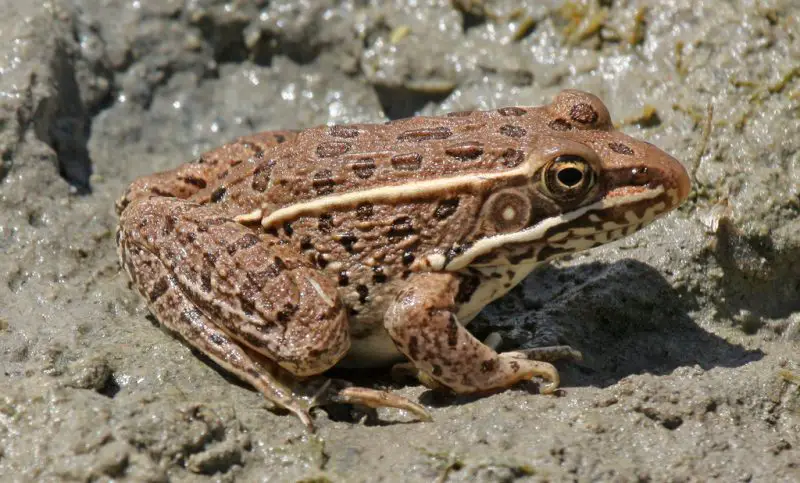
The Plains Leopard Frog is closely related to the Northern Leopard Frog but differs in its markings. It has fewer spots, and the light dorsolateral folds (the ridges running down its back) are often broken near the lower back. Adults are medium-sized, usually ranging from 2 to 4 inches long.
This species prefers open grasslands, prairies, and agricultural fields with nearby ponds or ditches. They are well adapted to drier environments compared to other frog species in Illinois, making them common in more open landscapes.
Plains Leopard Frogs are nocturnal feeders, hunting insects, small invertebrates, and occasionally smaller frogs. Their quick leaps and speed make them difficult to catch, both for predators and for observers.
In Illinois, they breed from March through May in shallow wetlands and flooded fields. Their call is a series of chuckling, short grunts, which can be heard during spring nights. Though not as widespread as bullfrogs, they are still regularly encountered in suitable habitats.
Crawfish Frog (Lithobates areolatus)
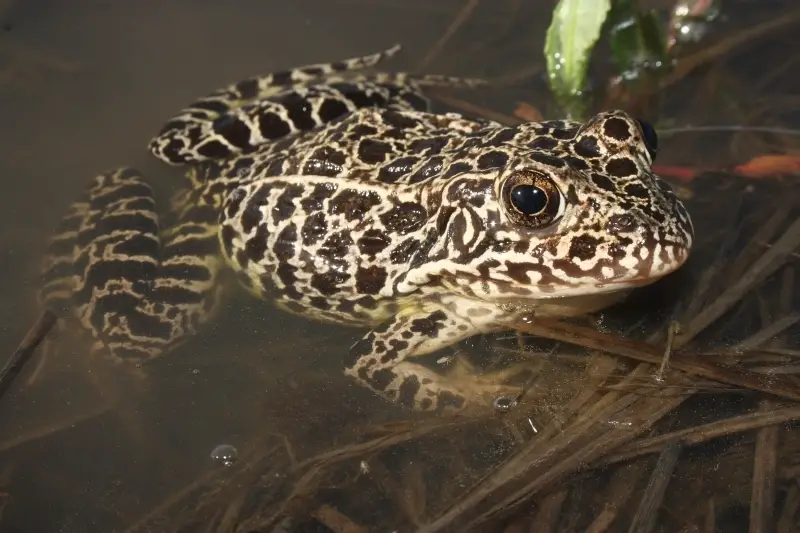
The Crawfish Frog is one of the more unusual frogs in Illinois, both in appearance and in behavior. Adults are medium to large, reaching 2.5 to 4 inches in length, with pale yellow to brown skin patterned by irregular dark spots ringed in lighter color. This spotted pattern gives them a camouflaged look against grassland soils. Unlike many frogs, their eyes are positioned more toward the top of the head, giving them a distinctive expression.
Their name comes from their unique habitat choice. Crawfish Frogs spend most of their lives in abandoned crayfish burrows, which provide shelter from predators and protection from extreme weather. They rarely leave these burrows except during rainy nights or when moving to breeding ponds in early spring.
Their diet includes insects, spiders, and other small invertebrates they encounter near their burrows. Because they spend much of their time underground, they are secretive and seldom seen. Predators include snakes, birds, and larger mammals, but their burrow-dwelling habits offer significant protection.
Breeding occurs in March and April when males migrate to shallow temporary ponds. Their call is a deep, resonant “snore,” lasting several seconds and carrying well across open grasslands. Females lay egg masses that hatch within a few weeks, and tadpoles develop quickly in seasonal waters.
Eastern Gray Treefrog (Hyla versicolor)
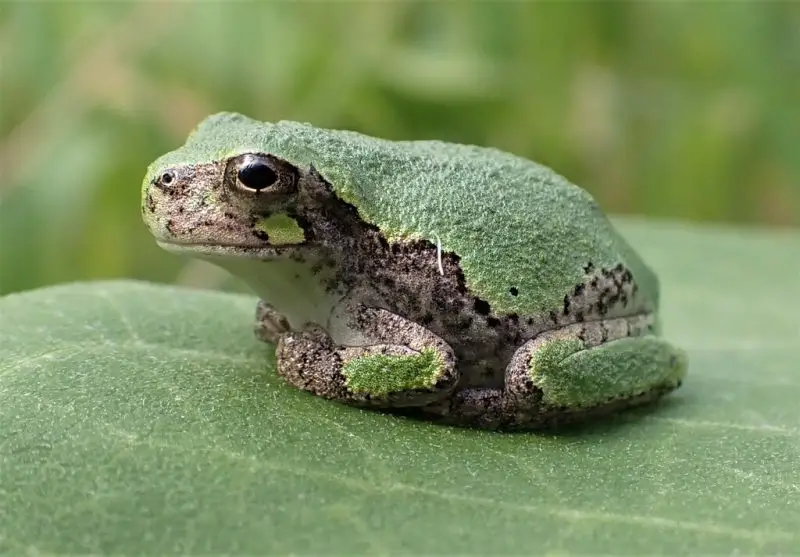
The Eastern Gray Treefrog is a small but remarkable amphibian, typically 1.5 to 2 inches in length. What makes it unique is its ability to change color, ranging from gray to green depending on temperature, humidity, and surroundings. This camouflage ability allows it to blend perfectly with tree bark and leaves. It also has bright yellow or orange patches on the inside of its hind legs, visible when it leaps.
As its name suggests, this frog is highly arboreal, spending much of its life in trees, shrubs, and woodland edges. It prefers habitats near ponds, lakes, and wetlands, but unlike aquatic frogs, it is more often heard than seen. During the day, it hides in tree holes, under bark, or in shaded vegetation.
Eastern Gray Treefrogs are insectivores, feeding on moths, flies, crickets, and other small arthropods. Their climbing ability, aided by sticky toe pads, makes them effective hunters even on vertical surfaces. In turn, they are preyed upon by snakes, birds, and small mammals.
Breeding season takes place from May to July. Males call with a loud, musical trill, especially after rainfall. Their calls are stronger and longer than those of their close relative, Cope’s Gray Treefrog, which can make identification in the field tricky. Females lay clusters of eggs attached to aquatic plants, where the tadpoles grow in summer.
Cope’s Gray Treefrog (Hyla chrysoscelis)
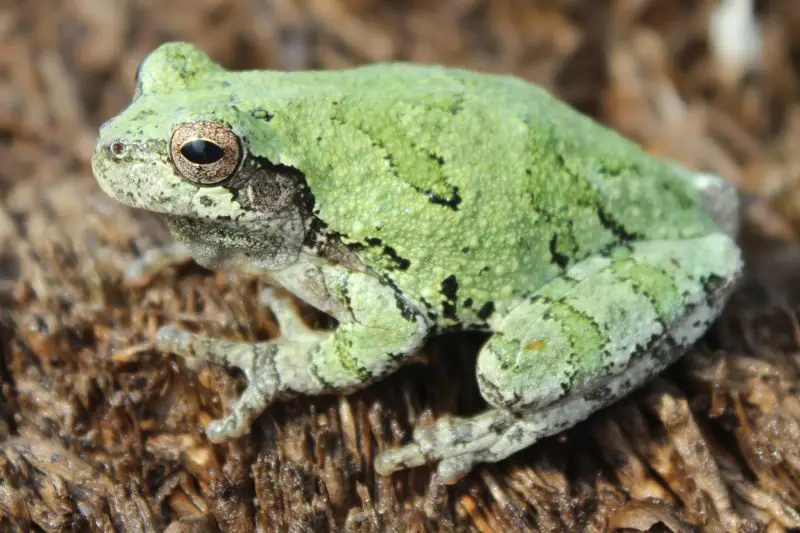
Cope’s Gray Treefrog is almost identical in appearance to the Eastern Gray Treefrog, measuring about 1.25 to 2 inches long, with the same ability to shift between gray and green. It also shows yellow-orange patches on the hind legs. Because of this similarity, they can only be reliably distinguished by their calls or genetic testing.
This species thrives in a wide range of habitats, including forests, wooded suburbs, orchards, and even backyard gardens, as long as water is nearby for breeding. They are more tolerant of drier and warmer environments compared to Eastern Gray Treefrogs, which makes them more common in southern Illinois.
Their diet mirrors that of other treefrogs, consisting of insects such as moths, beetles, and ants. They often perch on windowsills or porch lights at night, hunting insects drawn to the light. Their climbing ability allows them to exploit a variety of vertical surfaces.
Breeding begins in late spring and continues through mid-summer. The male’s call is a fast, buzzy trill—shorter and harsher than the Eastern Gray Treefrog’s musical trill. They gather around ponds, ditches, and temporary wetlands, where females deposit eggs in small floating clusters.
Blanchard’s Cricket Frog (Acris blanchardi)
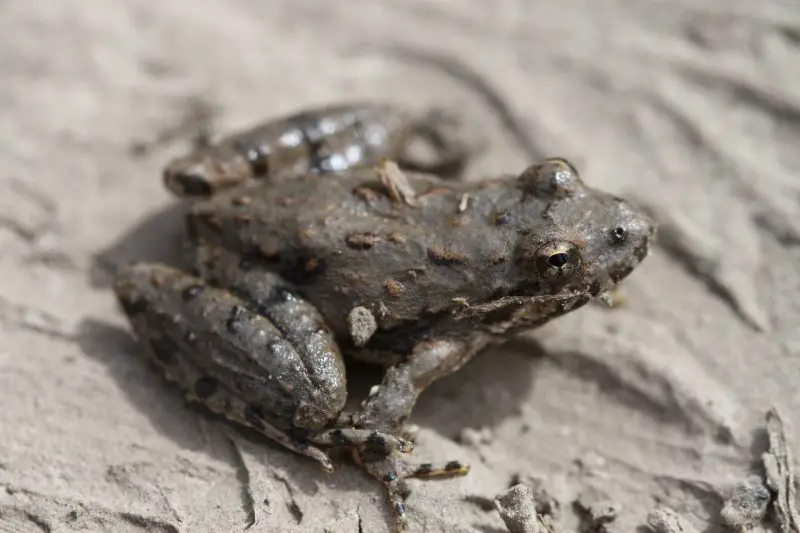
Blanchard’s Cricket Frog is the smallest frog in Illinois, usually only 0.75 to 1.5 inches long, but despite its size, it is one of the most energetic. Its skin varies from gray to green or brown, often with a dark triangle between the eyes and warty texture. A mid-dorsal stripe is sometimes present, giving it additional camouflage.
This species inhabits the shallow edges of ponds, lakes, marshes, and ditches. Unlike treefrogs, cricket frogs lack sticky toe pads and cannot climb well, so they spend most of their time on the ground or in the water. They are strong jumpers, often leaping several feet in a zigzag pattern when disturbed.
Their diet consists mainly of small insects such as mosquitoes, gnats, and flies. Because of their abundance, they are an important food source for snakes, birds, and larger frogs. Despite their size, they are resilient and capable of thriving in disturbed habitats, including roadside ditches and farm ponds.
Breeding occurs from May to August. Males produce a call that sounds like two marbles being tapped together rapidly—a distinctive “clicking” sound. Their loud choruses are common in summer and can be heard along shallow waters across much of Illinois.
Southern Leopard Frog (Lithobates sphenocephalus)
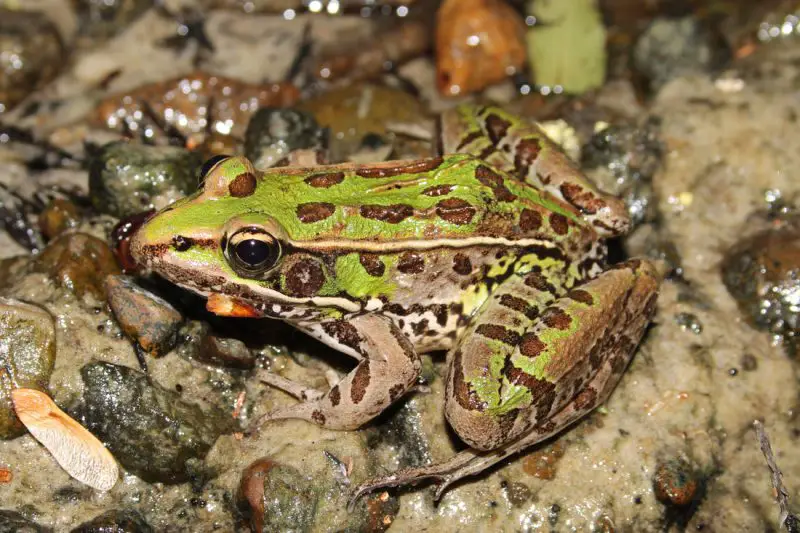
The Southern Leopard Frog is a medium-sized amphibian ranging from 2 to 4.5 inches long. It closely resembles both the Northern and Plains Leopard Frogs but can be distinguished by its more pointed snout and the presence of a small white spot in the center of the tympanum (eardrum). Its skin is smooth and usually light green to brown, scattered with irregular dark spots that extend across the back and sides. When startled, it leaps quickly into water, where its spotted pattern provides excellent camouflage among aquatic plants.
This species is commonly found in the southern half of Illinois, preferring warm, moist environments. It inhabits wetlands, shallow ponds, marshes, and slow-moving streams but is also seen in grassy fields adjacent to water. They are semi-aquatic and can often be observed resting at the edges of ponds or hopping through wet meadows during rainy nights.
The Southern Leopard Frog is an opportunistic predator, feeding on insects, spiders, earthworms, snails, and other small invertebrates. It uses a sit-and-wait hunting style, remaining motionless until prey comes within range, then striking with its long, sticky tongue. Its powerful legs allow it to capture prey quickly and escape predators such as herons, snakes, and raccoons.
Breeding season takes place from March through June, depending on weather conditions. Males call with a distinctive series of short, chuckling croaks that sound like laughter. Females lay egg masses containing several thousand eggs in shallow water attached to vegetation. Tadpoles develop rapidly and typically metamorphose into froglets by midsummer.
Wood Frog (Lithobates sylvaticus)
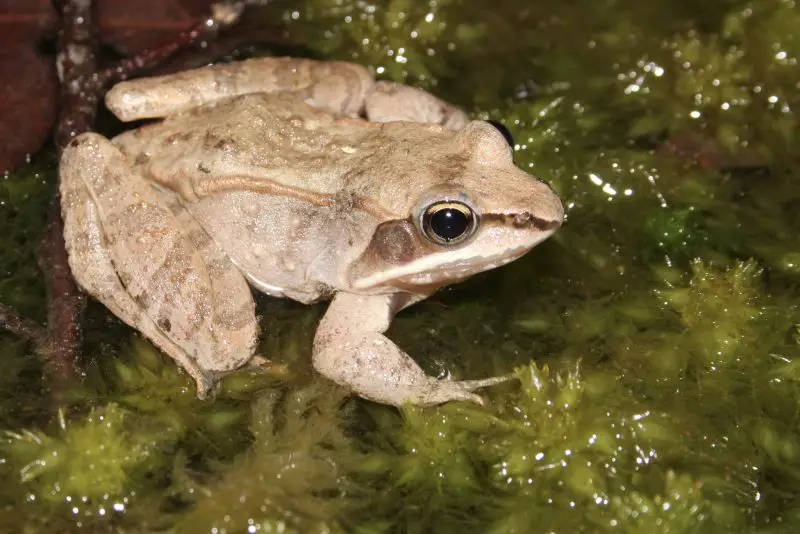
The Wood Frog is a small to medium-sized species measuring 1.5 to 2.75 inches long. It is best recognized by its light brown or tan coloration and the dark mask-like marking across its eyes, which gives it a distinctive appearance. Its body is more slender than many other frogs, and the color may vary depending on temperature and environment, helping it remain hidden in leaf litter.
This species is adapted to forested landscapes in northern Illinois, where it can survive far from permanent water. Unlike most frogs, Wood Frogs spend much of their time in woodlands, hiding under leaves, logs, or moss. They use temporary vernal pools for breeding, which prevents fish from preying on their eggs and tadpoles.
One of the most remarkable traits of the Wood Frog is its ability to survive freezing. During winter, it can tolerate ice forming inside its body by producing special sugars in its tissues that prevent cell damage. When spring arrives and temperatures rise, the frog “thaws out” and resumes activity—a survival strategy unmatched by most amphibians.
Breeding occurs very early, sometimes in late February or early March when ice is still present in ponds. Males produce a quacking call similar to a duck to attract females. Egg masses are deposited in large clumps in shallow water, where the tadpoles develop quickly before the pools dry out.
Spring Peeper (Pseudacris crucifer)
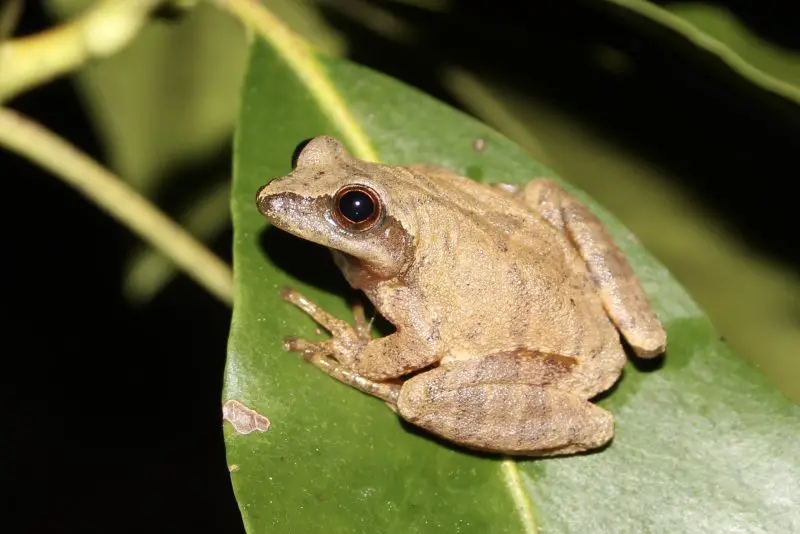
The Spring Peeper is a tiny but vocal frog, typically only 1 to 1.5 inches in length. It has a slender body with smooth tan to light brown skin, often marked by a dark X-shaped pattern on its back. Despite its small size, it produces one of the loudest and most recognizable calls of any frog in Illinois.
Spring Peepers live in wooded habitats near wetlands, ponds, and swamps. During the day, they remain hidden under logs, leaf litter, or vegetation. At night, particularly in early spring, males gather in large choruses near shallow water. Their high-pitched “peep” call carries over long distances, sometimes so loud that it drowns out all other evening sounds.
They feed on small invertebrates such as ants, beetles, moths, and spiders. Their small body size allows them to exploit niches unavailable to larger frogs, and they play an important role in controlling insect populations, especially in forested wetlands.
The breeding season starts very early, usually in March and April. Females lay clusters of 800 to 1,000 eggs in shallow water, attached to grasses or sticks. Tadpoles develop quickly, metamorphosing into tiny froglets by early summer. Spring Peepers are one of the first signs of spring in Illinois, marking the change of seasons with their calls.
Western Chorus Frog (Pseudacris triseriata)
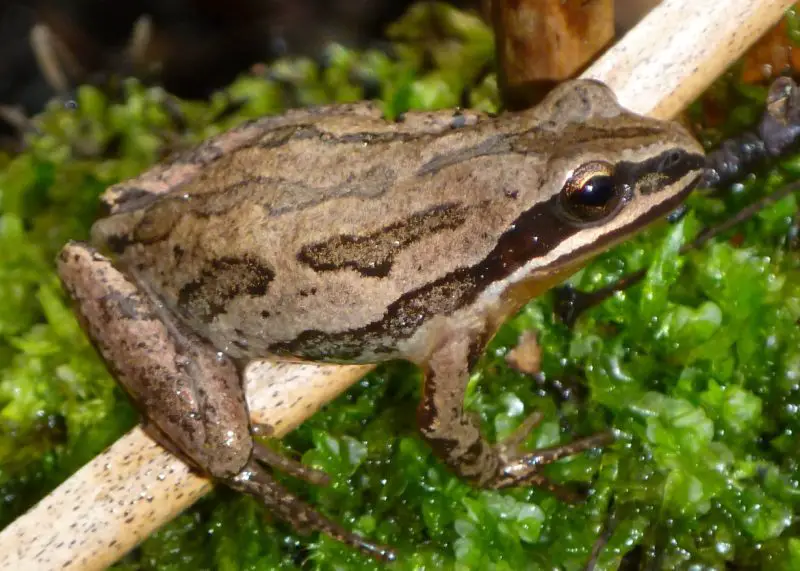
The Western Chorus Frog is a small species, usually 0.75 to 1.5 inches long. Its body is slender and typically gray, tan, or light brown, with three dark stripes running down its back. Some individuals may show broken or dotted stripes. A dark line extends from the nose through the eye, providing additional identification.
This frog inhabits grassy fields, wetlands, marshes, and shallow temporary ponds throughout Illinois. Unlike treefrogs, chorus frogs lack toe pads for climbing and are strictly ground-dwelling. They are most active in early spring, when their loud choruses fill the air around flooded fields and roadside ditches.
Their diet consists primarily of small insects such as ants, flies, gnats, and beetles. Despite their size, they are efficient predators, using their quick reflexes to snatch prey with their sticky tongues. They also serve as food for birds, snakes, and larger amphibians, making them a vital part of the ecosystem.
Breeding occurs from March to May. Males produce a call that sounds like running a fingernail across the teeth of a comb—a distinctive, short, repeated trill. Females lay eggs singly or in small clusters attached to vegetation in shallow water. Tadpoles grow rapidly, often completing metamorphosis before summer heat dries up their breeding ponds.
Boreal Chorus Frog (Pseudacris maculata)
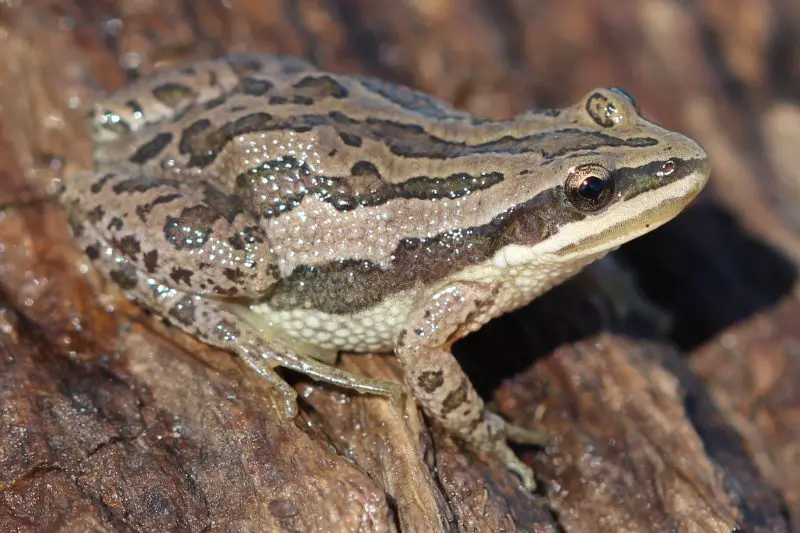
The Boreal Chorus Frog closely resembles the Western Chorus Frog but is found mostly in northern Illinois. Adults are small, measuring only 1 to 1.5 inches long, with a brown to gray body and dark stripes or broken markings along the back. The pattern is more variable than in the Western species, sometimes appearing as spots or broken lines.
They thrive in cooler environments such as northern marshes, wet grasslands, and temporary wetlands formed by melting snow and spring rains. Because they breed in early spring, often while snow is still melting, they are one of the hardiest frog species in Illinois.
Their diet is composed of mosquitoes, gnats, midges, and other small insects, making them an important natural control for nuisance pests. They are active at night and during wet weather, when insect activity is highest.
Breeding occurs from late March through early May, depending on climate. The male’s call is a rising “cree-ee-eek,” resembling the sound of dragging a thumb along a plastic comb. This call, repeated in choruses, is one of the first signs of spring in northern Illinois. Females lay several hundred eggs in small clumps on submerged vegetation, where the tadpoles hatch and develop quickly.
Best Time and Places to Observe Frogs in Illinois
The best time to observe frogs in Illinois is during spring and summer, when warm temperatures and seasonal rains make them most active. Early spring evenings, particularly in March and April, are ideal for hearing the loud choruses of species like Spring Peepers, Chorus Frogs, and Wood Frogs. These months are also the breeding season for many frogs, so shallow wetlands and temporary ponds are filled with activity.
Late spring through early summer, from May to July, is the prime time to spot larger species such as American Bullfrogs, Green Frogs, and Southern Leopard Frogs. During these months, they are easily seen along the edges of lakes, rivers, and permanent ponds. Their deep calls can be heard at night, and careful observation may reveal them basking on lily pads or resting on muddy banks.
In terms of locations, frogs can be observed across Illinois in wetlands, marshes, woodlands, and grasslands with nearby water. Northern Illinois is a good region to encounter species like the Boreal Chorus Frog and Wood Frog, while southern Illinois wetlands are home to Southern Leopard Frogs and Crawfish Frogs. State parks, nature preserves, and floodplain forests are excellent places to hear and see a variety of species, especially after rainfall.
FAQs About Frogs in Illinois
What is the most common frog in Illinois?
The American Bullfrog is the most common and widespread frog in Illinois. It thrives in lakes, ponds, and slow-moving rivers across the state. Its deep, booming call is often heard on summer nights.
When can you hear frogs calling in Illinois?
Frog calling begins as early as late February in southern Illinois with Wood Frogs and Spring Peepers. The peak chorus season is from March to June, depending on the species. Bullfrogs and Green Frogs continue calling into July and August.
Where can I see the greatest variety of frogs in Illinois?
Wetland preserves, floodplain forests, and shallow marshes provide the greatest diversity. Areas like the Cache River State Natural Area in southern Illinois and forest preserves near the Chicago region in the north are excellent for frog watching.
Do frogs in Illinois hibernate?
Yes, frogs in Illinois enter a state of dormancy during winter. Some species, like the American Bullfrog, burrow into the mud at the bottom of ponds, while Wood Frogs can actually survive freezing and thawing cycles in forest floor leaf litter.
Are any frogs in Illinois endangered?
Most frog species in Illinois remain relatively common, but habitat loss and water pollution have reduced populations of certain species, including the Crawfish Frog. Conservation efforts focus on preserving wetlands and breeding habitats to protect these amphibians.






